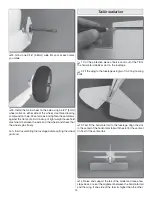
3
differ slightly from the photos. In those instances the written
instructions should be considered as correct.
3. You must take time to
build straight, true
and
strong
.
4. You must use an R/C radio system that is in good condition,
a correctly sized engine, and other components as specified
in this instruction manual. All components must be correctly
installed so that the model operates correctly on the ground
and in the air. You must check the operation of the model and
all components before
every
flight.
5. If you are not an experienced pilot or have not flown
this type of model before, we recommend that you get the
assistance of an experienced pilot in your R/C club for
your first flights. If you’re not a member of a club, your local
hobby shop has information about clubs in your area whose
membership includes experienced pilots.
6. While this kit has been flight tested to exceed normal use,
if the plane will be used for extremely high stress flying, such
as racing, or if a motor larger than one in the recommended
range is used, the modeler is responsible for taking steps to
reinforce the high stress points and/or substituting hardware
more suitable for the increased stress.
7.
WARNING:
The cowl, wheel pants, and some fairings are
made of fiberglass, the fibers of which may cause eye, skin
and respiratory tract irritation. Never blow into or on a part
to remove fiberglass dust, as the dust will blow back into
your eyes. Always wear safety goggles, a particle mask and
rubber gloves when grinding, drilling and sanding fiberglass
parts. Vacuum the parts and the work area thoroughly after
working with fiberglass parts.
We, as the kit manufacturer, provide you with a top quality,
thoroughly tested kit and instructions, but ultimately the
quality and fl yability of your fi nished model depends
on how you build it; therefore, we cannot in any way
guarantee the performance of your completed model,
and no representations are expressed or implied as to the
performance or safety of your completed model.
Remember:
Take your time and follow the instructions to
end up with a well-built model that is straight and true.
ITEMS REQUIRED
Radio Equipment
A 4-channel minimum radio system is required to fly this
model. We recommend using a 6-channel radio so that wing
flaps can be used.
❏
Futaba
®
R617FS 7-channel 2.4GHz Receiver
OR
❏
Futaba R114F FM Micro Receiver
(Low Band – FUTL0442, High Band – FUTL0443)
❏
Futaba FM Single Conversion Short Crystal
(Low Band – FUTL62**, High Band – FUTL63**)
❏
(2) 12" [300mm] servo extension
(HCAM2711 for Futaba)
No Flaps Option
❏
(1) Y-harness (FUTM4130)
❏
(4) Futaba 3115 Micro Precision Servo (FUTM0415)
OR
❏
(4) minimum 39 oz-in (2.8 kg-cm) Micro Servos
Operable Flaps Option
❏
(2) Y-harness (FUTM4130)
❏
(2) 6" [150mm] servo extension (HCAM2701 for Futaba)
❏
(6) Futaba 3115 Micro Precision Servo (FUTM0415)
OR
❏
(6) minimum 39 oz-in (2.8 kg-cm) Micro Servos
Motor, ESC and Propeller
❏
Great Planes RimFire .32 (42-50-800kV) Brushless
Outrunner Motor (GPMG4700)
❏
Great Planes Silver Series 45A Brushless ESC
(GPMM1840)
❏
APC 12x8 Electric Propeller (APCQ4133)
Battery and Charger
Other battery packs will also work in this model, but please
be sure to always use a 4S LiPo pack that can supply at least
45A continuous.
❏
FlightPower
®
EON-X
™
4350mAh 14.8V 30C LiPo
(FPWP6576)
❏
Great Planes ElectriFly Triton
™
EQ AC/DC Charger
(GPMM3155)
LIPO WARNING!!
Read the entire instruction sheet included with the battery.
Failure to follow all instructions could cause permanent
damage to the battery and its surroundings, and cause
bodily harm!
• ONLY use a LiPo approved charger.
• NEVER charge in excess of 4.20V per cell.
• ONLY charge through the “charge” lead. NEVER charge
through the “discharge” lead.
• NEVER charge at currents greater than 1C.
• ALWAYS set charger’s output volts to match battery
volts.
• ALWAYS charge in a fi reproof location.
• NEVER trickle charge.
• NEVER allow battery temperature to exceed 150° F (65° C).
• NEVER disassemble or modify pack wiring in any way
or puncture cells.
• NEVER discharge below 3.0V per cell
• NEVER place on combustible materials or leave
unattended during charge or discharge.
• ALWAYS KEEP OUT OF REACH OF CHILDREN.




































